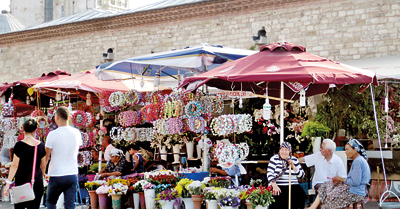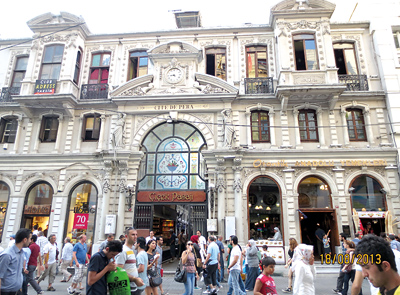Leaving Istanbul with a memorable gift
The Bosphorus is one of those places you recall from distant geography lessons and map-marking at school so it seems almost surreal to be on a boat trip down this strait which lies between the Black Sea and the Sea of Marmara and has on either bank the city sprawl of Istanbul. One of the world’s largest cities, Istanbul straddles Asia and Europe and some 60 percent of its population of around 14 million live on the Asian side and travel to the European side to work, our guide tells us.

Flower sellers adjoining Taksim Square
The name ‘Bosphorus’ means cow’s crossing, harking back to an old Greek myth where the father of the Gods Zeus transformed his love Io into a cow to protect her from his wife Hera’s wrath. But Hera the woman scorned had her revenge by setting a horse fly on Io, who it is said, took flight, leaping over the Bosphorus and leaving in her wake, a legend still retold.
Large ferry boats depart from the dock at Eminonu opposite the New Mosque and we are booked for a two-hour afternoon cruise. Our departure time is 4 o’clock and the boat leaves on the dot:we have made it with seconds to spare, in typical Lankan style. The top deck is full with tourists and families and, for those of us unable to grab a shady spot it’s a scenic if sweaty cruise in the heat of the afternoon sun. Istanbul in August, we find is as every bit as hot as Colombo.
Our Turkish Airlines liaison officer Mehmet Tiryakioglu points out the landmarks as the ferry makes its way smoothly out- the impressive Dolmabahce Palace with its ornate architecture, and on the Asian side the somewhat forbidding Rumeli fortress, summer palaces and what the Turks calls ‘Yalis’- seaside villas, coffee shops and tea houses, parks and promenades….the waterside properties are some valuable real estate.
Seagulls swoop around as the boat glides on and under the two bridges spanning the Bosphorus, the first one of the world’s largest suspension bridge, the Bosphorus Bridge ( 1074 metres long) and a while later the Fatih Sultan Mehmet Bridge (1090 metres long) built in 1973 and 1988 respectively. A third bridge between the two continents is under construction closer to the point where the Bosphorus meets the Black Sea. When the heat gets too much, we head down to the two airconditioned decks below, and find the view just as good.
Topkapi Palace
Now a museum and World Heritage site, Topkavi Palace embodies the blossoming of Turkish art and architecture. Built by the young Sultan Mehmet in the 1460s and ‘70s, it was where he held court followed by 26 other Ottoman sultans who added their own touches to it. Considered the greatest palace of the Ottomans, a royal seat for close to 400 years, it is a vast complex of courtyards and buildings holding not just the royal residences but the Imperial Mint, the Tower of Justice, the harem and even a hospital. From here, the Sultans shifted to Dolmabahce and Topkapi was restored and turned into a museum in 1924.

Istiklal Street: Istanbul’s most happening address
The beautiful gold emblazoned fountain outside is an indication of the grand architecture that characterizes this place. The entrance is through the high vaulted Imperial Gate: prepare to walk, for long avenues separate the various courtyards. We pass the 6th Century church, the Hagia Irene on the left and to the right, stop to admire the blue of the Bosphorus. The 700 sq. ft compound was strategically chosen, no doubt for it offers stunning views of the Golden Horn, the Bosphorus and the Sea of Marmara.
The Museum sections starts with the second courtyard (there are four) and here there are interesting places to visit like the Tower of Justice and the harem section for which a special entry fee is charged. It was not just the Sultan’s concubines and eunuchs who lived here but also other members of his family, we learn, and at the height of empire it had as many as 400 rooms.
The third courtyard was the private domain of the sultan and it was entered —only by special permission- through the Gate of Felicity, guarded by the White Eunuchs. The imperial university, the throne room, the treasury of the sultan and the quarters housing the sacred relics are in this section.
The treasury section of the Topkapi Palace Museum believed to be the richest collection of its kind in the world offers a glimpse at the opulent lifestyle of the Ottoman sultans. The gems on display, some as large as duck eggs are almost too huge to be real. Another curious collection is one of clocks, from the 16th to 19th centuries, many of English make and as fanciful as can be.
Another section has the sacred relics which includes the swords and bow of Prophet Mohammed and his mantle. The seal of the Prophet, hairs from his beard, his footprint and a letter are other exhibits in the showcases in these rooms, though time constraints did not allow us a visit.
The Suleimanye Mosque
Built at the time when the Ottoman Empire was at its most glorious, this is the largest of Istanbul’s 3000 mosques but strangely, is not at all crowded. Considered among famous architect Mimar Sinan’s masterpieces, it was wrought at the command of Sultan Suleyman the Magnificient in 1557. Suleiman was the fourth Sultan to rule Istanbul and the 16th after the founding of the Ottoman empire and this detail can be seen in the four minarets and 16 galleries of the mosque.
Though there are the obligatory souvenir stalls selling keytags and shawls outside and a handful of teashops and restaurants, inside the walled compound the atmosphere is quiet and worshipful, sans the long queues that characterized the Blue Mosque. As we have now come to expect, the interior is one of stunning grace.
Taksim Square
During our four days in Istanbul we have seen glimpses of the city’s majestic past and felt in some small measure the diverse influences left by the crosswinds that swirled around this land. Fittingly our last afternoon in Istanbul is spent in the vicinity of the city’s contemporary heart- Taksim Square. The vast square is a far cry from the images we recall of the recent protests, a few tourists and locals desultorily meandering past the Independence monument dedicated to Ataturk, but the watchful presence of police trucks in one corner is a reminder that this is where much of the action takes place…
Then it’s on to Istiklal Street, Istanbul’s most happening address which leads off from Taksim Square. Closed to traffic, only a vintage tram car plies its 2.5 km length but it’s more fun to join the throng and potter along, taking in the street musicians, the heritage buildings, the boutiques, art galleries, bookstores, all inviting a stop. Day or night, Istiklal is decorated and vibrant.
And so we leave with lasting impressions of the ancient and modern, how well Istanbul presents it, a memorable gift to a traveller – even one passing quickly through like the ships on the Bosphorus.
(The Sunday Times was part of a media tour to Istanbul on the invitation of Turkish Airlines)
comments powered by Disqus

